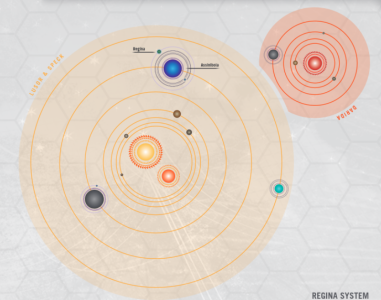I've just finished reading the section on Regina in Behind The Claw, and I'm wondering what the "cycle" of day and night looks like on the planet (or it should be called a moon, I guess).
So Regina is orbiting a gas giant, which is itself orbiting binary stars. For that alone, I imagine it must mean that on top of the night/day cycle coming from the spin of Regina (assuming it's not tidally locked, but I've seen no mention of that), it must have a long night for the whole time the gas giant is between it and those stars. How long that long night goes depends on the time it takes for Regina to make one revolution around the gas giant, but I'd assume it must be at least a few months? So in that configuration, you have a few months of pitch black, then some shorter time with night and day but with the days having at first very little light, coming a bit stronger every day, then a regular cycle of night and day when the gas giant is not interfering anymore, then days start to dim again until the next long night start.
But then, there is Darida, the third star orbiting around the whole system! This can't be fast, I'd expect it to take decades to perform one revolution around the binary stars, maybe? So that would mean that there are long period of months or maybe years during which Regina is almost always in daylight, and similarly long period during which the behavior described in my previous paragraph is observed? Do I read that correctly?
So Regina is orbiting a gas giant, which is itself orbiting binary stars. For that alone, I imagine it must mean that on top of the night/day cycle coming from the spin of Regina (assuming it's not tidally locked, but I've seen no mention of that), it must have a long night for the whole time the gas giant is between it and those stars. How long that long night goes depends on the time it takes for Regina to make one revolution around the gas giant, but I'd assume it must be at least a few months? So in that configuration, you have a few months of pitch black, then some shorter time with night and day but with the days having at first very little light, coming a bit stronger every day, then a regular cycle of night and day when the gas giant is not interfering anymore, then days start to dim again until the next long night start.
But then, there is Darida, the third star orbiting around the whole system! This can't be fast, I'd expect it to take decades to perform one revolution around the binary stars, maybe? So that would mean that there are long period of months or maybe years during which Regina is almost always in daylight, and similarly long period during which the behavior described in my previous paragraph is observed? Do I read that correctly?
Last edited:

